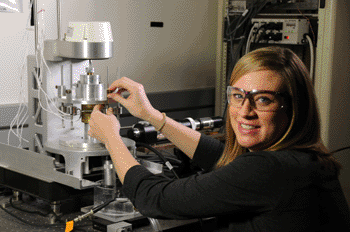Prototype Ultrasound Bioreactor Assesses Engineers Tissue while Making It
By LabMedica International staff writers
Posted on 17 May 2012
American scientists have devised a prototype bioreactor--a device for culturing cells to create engineered tissues--that both stimulates and assesses tissue as it grows, simulating natural mechanisms while eliminating the need to stop periodically to snip off samples for analysis. Tissue created in this manner might soon be used to replace, for example, injured or diseased cartilage in the hip and knee.Posted on 17 May 2012
Conventional techniques for evaluating the development and properties of engineered tissue are time-consuming, destructive and need to be repeated many times. By using ultrasound to monitor tissue during processing without destroying it, the novel bioreactor could be a faster and less expensive alternative.

Image: Biomedical engineer Jenni Popp with NIST’s prototype bioreactor for tissue engineering. The bioreactor both stimulates and evaluates engineered tissue as it grows (Photo courtesy of Burrus/NIST).
Natural cartilage is created by specialized cells that generate large amounts of structural proteins to weave a tough support material called extracellular matrix. Lacking blood vessels, cartilage has limited capability to heal from arthritis, injuries, or other defects. Damage can be treated with drugs or joint replacement but results can be imperfect. Engineered tissue is used in some medical treatments but is not yet a routine option to metal or plastic joint replacements. The NIST bioreactor provides researchers with a noninvasive way to monitor vital structural changes in developing tissue.
The NIST/CU bioreactor can fit inside a standard incubator, which controls temperature and acidity in the growth environment. The bioreactor applies force to stimulate five small cubes of cartilage cells embedded in water-based gels. The mechanical force mimics the natural stimuli needed for the cells to create matrix proteins and develop the structure and properties of real cartilage. Ultrasound techniques monitor tissue changes over time, while a digital video microscope takes images.
Early research indicates the bioreactor both stimulates and monitors development of cells, matrix content, and scaffolds to make three-dimensional (3D) engineered cartilage. The cell-laden gels were stimulated twice daily for an hour. Sulfated glycosaminoglycan (sGAG)--which combines with fibrous proteins to form the extracellular matrix--increased significantly after seven days. This structural change was detected by a significant decrease in ultrasound signals after seven days.
The research described in the article was performed at and led by NIST. The bioreactor is a collaborative project with several investigators from the University of Colorado Boulder (CU; USA) department of chemical and biological engineering.
NIST and CU researchers are continuing to develop ultrasonic measurement methods and plan to conduct longer experiments. The bioreactor is also being used by other academic researchers as a tool for confirming mathematical models of biokinetics, the study of growth and movement in developing tissue.
Related Links:
National Institute of Standards and Technology
University of Colorado Boulder













